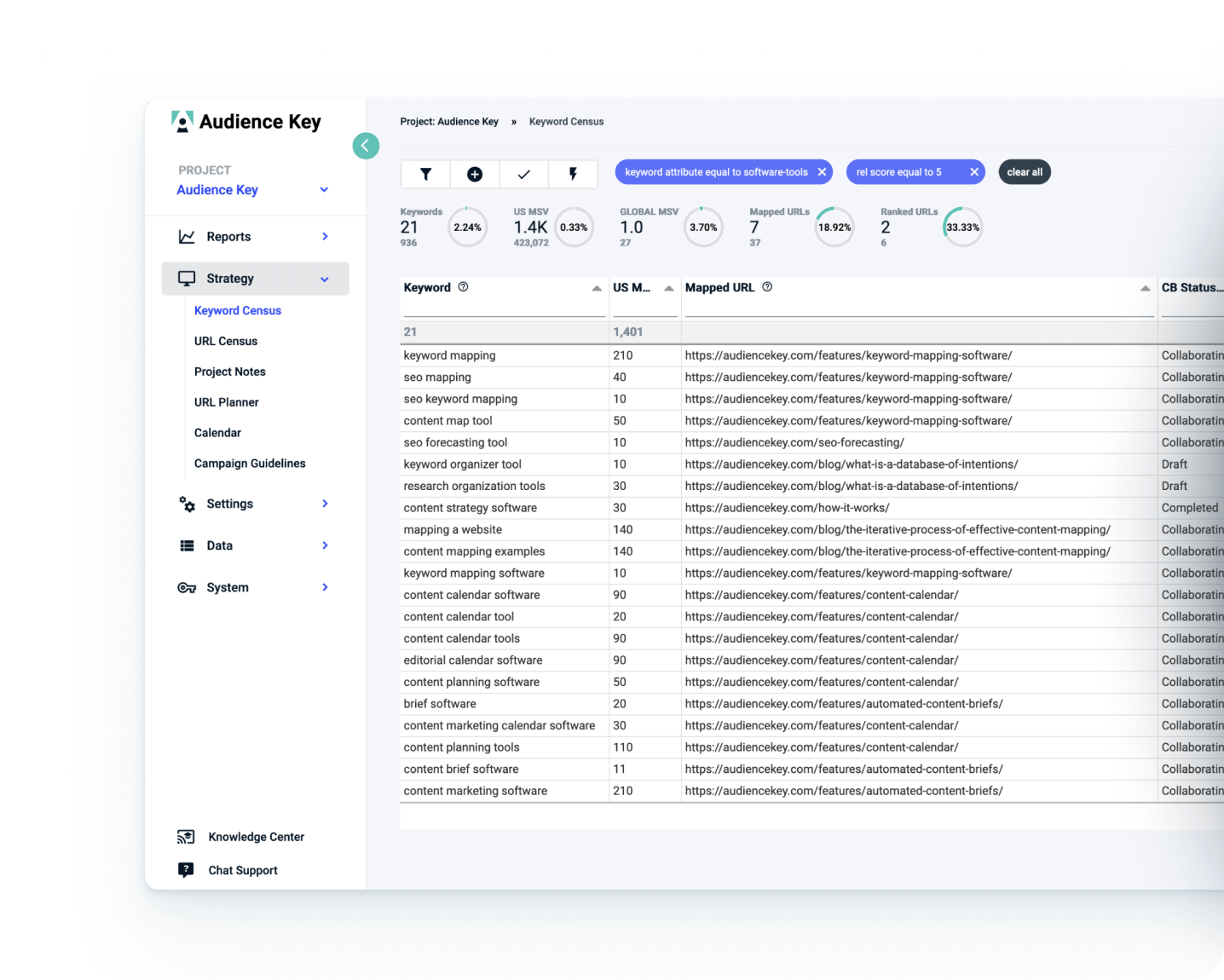… Or: How to Prevent Your Keyword Strategy From Becoming a Big Waste of Time
Too often keyword research remains siloed and disconnected from the actual content creation and optimization process. Or it gets shared with the content creation team, but they lack a clear directive on how to integrate the SEO keyword research.
This is why SEO strategy often falls short. We identify keywords, map them to a page on our website, create some “optimized” content around it, publish it and hope for the best.
Have you ever read a marketing strategy playbook that includes the step: “Hope for the best”? Of course not, but that’s what we often do with our keyword strategies.
What Content Marketers Can Learn From Decision Analytics in Business Intelligence
A key concept in the world of business intelligence commonly referred to as decision analytics (aka decision analysis) provides a valuable and transferable concept to SEO content strategy. Decision analytics as defined by investopedia.com:
“Decision analysis is a systematic, quantitative, and visual approach to making strategic business decisions.”
Essentially, decision analytics puts the right data into
- The right view …
- At the right time …
- For the right person.
…so that the data can be actualized during decision-making moments. That, friends, is data driven decision making.
3 common keyword strategy gaps
Without data insights, a keyword strategy becomes a guessing game. Keyword strategy most often falls short in three places, or gaps.
- Gap between topic ideation and writing: The writer didn’t receive the keywords or didn’t properly incorporate the keywords into the content.
- Gap between editing and publishing: The editorial team didn’t evaluate the content to make sure keywords were properly incorporated; likewise, they didn’t go back and remap keywords that the writer found during the writing process.
- Gap between live content and further optimization: Once your content goes live, you never touch the content again. You hope for the best.
Keyword research and analysis is a test, learn, iterate approach belonging at every stage of your keyword strategy. Keyword strategy is not a one-and-done, set-and-forget approach to content creation and search engine optimization.
‘Keyword strategy’ defined
The perfect keyword strategy begins with an idea and ends with a page 1 search engine results page (SERP) position, preferably “above the fold.”
- Identify keywords: List words and phrases that are familiar to you and your potential customers/clients/patrons/users.
- Plan: Map keywords to existing pages on your website, or create new pages to support those keywords.
- Create and optimize: Write, edit, and publish new content or optimize existing content to incorporate those keywords.
- Measure: Monitor the content’s performance to ensure that your mapped keywords are working the way you want.
- Iterate: Update the content, remap keywords, and look for new opportunities.
The trifecta of keyword strategy happens when you use data insights throughout the entire SEO strategy. You find keyword phrases that have …
- Relevance to your business: You build a census of keywords that align with your services, products, and business goals.
- Importance to your customers: Your keyword research suggests that there is a good amount of estimated monthly search volume (MSV) that people are searching for solutions that you offer.
- Significance to your competitors: Your competitors are either not ranking for the keywords, or they’re within striking distance (page 2 or 3). Strike while the SEO iron is hot.
When you add decision analytics to your keyword strategy and content creation processes, you no longer have to “hope for the best.” Next, we explain how to use data insights in the prewriting, post-writing, and post-publication stages of content creation.
Prewriting — How to Use Data Insights to Guide Your Content Creators
With the right data visualization, your content creators should be able to take your keyword strategy and easily understand the weight and importance of each keyword that you’ve mapped to a page.
In the following example, we use a landscaping company that wants content to explain options for building residential retaining walls. We tentatively call it “6 Great Retaining Wall Ideas” and perform keyword research.
The prewriting stage of keyword strategy involves identifying and mapping relevant keywords to a URL, or page.
- Identify keywords, map them to a URL, and score them
We identify 12 keywords that we map to the blog post, and we score them based on relevancy (Rel Score) for the landscaping company. This actualization step converts the keywords from a list into a guideline for the content creator.
A Rel Score of 4 or 5 means the keyword is the primary focus and should be supported in the title tag, headline, URL and meta description as possible. A Rel Score of 2 or 3 is a signal to try to use the keyword phrase, or a variation of the phrase, elsewhere in the body copy and/or subheads.
| Keyword | Estimated MSV | Relevancy Score |
| types of retaining walls | 1,300 | 4 |
| different types of retaining walls | 170 | 2 |
| garden retaining wall | 590 | 3 |
| garden retaining wall ideas | 50 | 3 |
| cinder block retaining wall | 1,000 | 3 |
| driveway retaining wall ideas | 30 | 3 |
| front yard retaining wall ideas | 40 | 3 |
| landscaping retaining wall ideas | 50 | 3 |
| retaining wall design | 1,900 | 1 |
| retaining wall ideas | 2,900 | 5 |
| rock retaining wall ideas | 50 | 3 |
| stone retaining wall ideas | 90 | 3 |
- Create the content
The keyword list inspires the outline for this piece of content. Keyword research identifies six types of retaining walls that serve as the outline for our page copy: garden, front yard, back yard, cinder block, wood, and rock/stone.
Visually, our keyword strategy for 6 Great Retaining Wall Ideas looks like this:
Post-Writing — Seal Your Content With a KISS™
Now that you’ve written the content, how does your content measure up? This is where you can make sure it doesn’t fall short of your keyword strategy using decision analytics.
The KISS metric is the keyword implementation support score — a built-in algorithm in Audience Key that measures how well your content supports your keyword strategy. Each keyword is scored between 0 and 100, and the content is given a total overall score.
Our “6 Great Ideas for Retaining Walls” post hit almost every mapped keyword except “driveway retaining wall ideas,” so we need to fix that. We added two sentences to the section about front yard retaining walls to include mention of driveway retaining wall ideas. Boom. We’ve got a KISS of 30 now for “driveway retaining wall ideas.”
Last step? We add an SEO title tag and a meta description that include the keyword phrase “retaining wall ideas,” and that keyword in the draft baseline with a KISS of 35 now has a perfect KISS of 100. How sweet is that?
We are happy with the overall KISS improvement from a 13.69 to a 32.46 KISS score for this piece of content. The data from all 13 keywords have influenced decisions for outlining and shaping the content. We feel solid in our choices and are ready to publish the piece.
Post-Publication: Closing the Content-SEO Feedback Loop
No longer hoping for the best, we monitor performance. We use key performance indicators (SERP features and Rank Zone) to assess the effectiveness of our content and reassess our mapping strategy, as well as identify optimization opportunities.
Look the URL’s mapped keywords for three key markers:
- Keyword blurring: a different URL begins to softly rank for a mapped keyword rather than the intended mapped URL
- Keyword striking distance: content is ranking just shy of page 1 of search engine results pages
- Keyword gaps: content isn’t ranking at all for the mapped keywords
Keyword blurring
In the next example, the data for one keyword phrase, “retaining wall landscapers,” shows that the company had three pages competing for this phrase. With this data, our strategist made further optimizations to the content on all three pages, so that the intended page — 6 Great Ideas for Retaining Walls — ranks for the keyword phrase, rather than the company’s “landscaping” pages.
Providing time for Google to adjust to the improved content targeting you can now see the blurring between URLs for this keyword phrase is gone, and the intended page “owns” the phrase “retaining wall landscapers.”
Keyword striking distance
The data also tells us that, after about 90 days of watching this content, some keyword phrases were ranking, but they tended to show on page 2 of Google search engine results (SERPs). For those that had Rel Scores of 4 and 5, yet were within striking distance, the content strategist has clear data that drives her decisions: With a few tweaks, those striking distance keywords get bumped from page 2 to page 1 of SERPs.
Keyword gap analysis
The retaining wall post is not ranking for four keywords: cinder block retaining wall, garden retaining wall, rock retaining wall ideas, and wood retaining wall ideas. The data to suggests there’s significant interest in these topics (1,850 monthly search volume), so the content strategist can either add more to the existing post (/6-types-of-retaining-walls/) or create a new post with specific ideas and photos showing cinder block, garden, rock and wood retaining wall ideas.
TL;DR? What’s The Bottom Line
Decision analytics eliminates “hoping for the best” by actualizing your keyword strategy. The strategist can continue to monitor the performance of this page to make sure the client — in this case, the landscaping company — is ranking for the right keywords.





